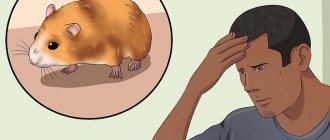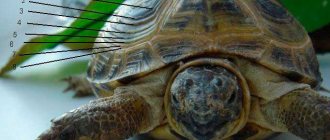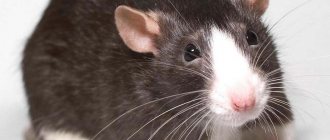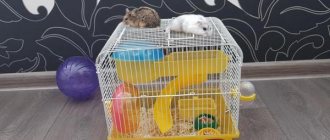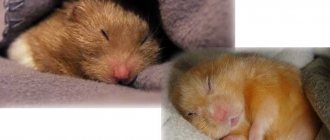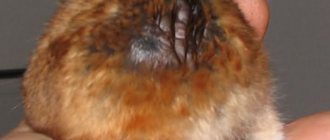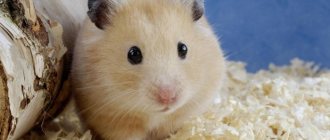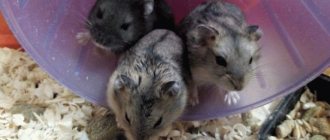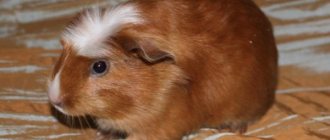Hamsters are active and fairly unpretentious rodents. Recently, they can be found as pets in many families, but, unfortunately, they live very short lives. Therefore, future owners need to be able to determine the age of hamsters before purchasing them. And for this we will find out the basic parameters of hamsters at different stages of life.
How old do hamsters grow?
Newborn Syrian hamsters are born on days 16–18 of pregnancy, and Djungarian hamsters on days 21–26. At first, representatives of both breeds have no hair at all, their skin is pink, and their eyes and ears are closed.
The average weight of a newborn jungarik most often does not exceed 3–5 grams. The body weight of their Syrian counterparts is usually 50% greater.
After 3–4 days, the skin of small rodents turns pale and sparse fluff appears on it. By 5–6 days the hamster can already hear. By 12 days, the babies’ bodies will be completely covered with hair, and they will weigh almost 2 times more than at birth. On day 14, hamsters' eyes open, and after another 2 weeks they reach a weight that is equal to half the body weight of an adult and can feed on their own.
The age at which hamsters continue to grow depends directly on the breed of these rodents. Thus, Djungarian babies grow actively until about 1–1.5 months.
Syrian hamsters – 1–2 weeks longer. Upon reaching this age, they are already considered adults and grow not in height, but in width. The final growth and weight gain of Djungarian and Syrian hamsters will last up to 5–6 months.
On average, the body weight of the Djungarian by 180 days of age reaches 40–60 grams, the Syrian - 140 grams.
Other breeds
When purchasing a hamster of any breed, you can generally rely on the above points when determining their age. The exception is such a parameter as weight. It may differ for different breeds. And factors such as behavior, fur, ears and eyes are the same for all species.
IMPORTANT! It is worth paying attention to the following factors when choosing a hamster:
- if the hamster is more than 3 months old, it will weigh more than 40 grams;
- females increase in weight up to 4 months, after which she becomes an adult and her weight does not change, which indicates her readiness to mate;
- if the animal is more than 3 months old, its length will be at least 8 centimeters;
- young individuals are always playful and active, constantly eating, males start fights and attract females to their attention, and older animals behave calmly and stay away from everyone else.
How to find out how old a hamster is
Unfortunately, methods that allow you to determine the age of a hamster with an accuracy of up to a day do not yet exist, so even experienced specialists can do this with an error of several weeks.
An inexperienced owner will be able to find out the age of a hamster using proven methods.
Age of hamsters by appearance
You can find out how many days, weeks or years old a Djungarian or Syrian hamster is by using a number of characteristics:
- Eyes. Until about 14–15 days from birth, the eyes of small hamsters are still closed. In young and healthy Djungarians, the eyes are shiny, clear, not bulging and have the same color, but in the elderly and sick, on the contrary, they seem to be clouded. A young and healthy Syrian hamster's eyes should be black, shiny and slightly protruding, and the mucous membrane of the eyelids should be pinkish and slightly moist. If a Syrian's eyes are sunken or, conversely, become too bulging, dry, covered with a film, and the eyelids are inflamed, this is most likely a sign of old age or ill health of the rodent.
- Ears. The fur on the ears of young hamsters of both breeds is lighter and covered with soft fluff. By old age it completely disappears.
- Coat. Full fur appears in small hamsters at about 12–15 days. If a rodent has bald spots, this most often indicates that the animal is sick or elderly. In addition, bald spots often occur in babies who are not yet a month old, because their coat has not yet fully formed. Normally, the fur of young and healthy Djungarian and Syrian hamsters should be thick, soft and bright, without any defects.
- Dark spots. The age of the Djungarian hamster and its Syrian counterpart can also be determined by the presence of pigment spots. Normally, they are located in the hip area and look like small lumps, but the most noticeable ones are in the abdomen and genital area. The color of the spots should be noticeably darker than the color of the rodent's skin. With age, their number increases. In addition, in males their number is noticeably greater than in females.
Age of hamsters by behavior
The easiest way to determine how old or months old a hamster is is to observe its behavior.
Young hamsters of any breed are very active, especially at night. They move a lot, squeak and play, and start eating immediately after waking up. Elderly individuals, on the contrary, hardly move. Most of the time they sleep or sit in a corner of the cage, chewing their food thoroughly.
By body size and weight
Measuring body weight and length will also help you understand how old your hamster is. In the first months of life, both Djungarians and Syrians usually weigh slightly less than 40 g.
A six-month-old adult Djungarian hamster most often weighs 40–60 g with an extended body length of no more than 8 cm. The average weight of an adult Syrian hamster is 100–120 g with a body length of 13 cm.
Age of hamsters by sexual activity
Puberty in hamsters occurs as early as 1 month. However, mating at this age is not recommended, since the female’s body is not yet fully formed. Mating too early can cause the birth of cubs with all sorts of abnormalities that are incompatible with life.
Young females sometimes have too little milk to feed their offspring and often simply eat their young.
The best age for mating is 4–6 months. At this point, the female’s weight should be at least 2/3 of the adult’s body weight. To restore strength after pregnancy and childbirth, the interval between matings of hamsters should be 2-3 months.
Reproductive function in females lasts up to 1.5 years, and in males - throughout life.
Reviews
Oleg, 34 years old
My ten year old daughter loves rodents. Whom we didn’t already have! Recently we decided to buy a light brown Syrian. The daughter is delighted. I’ll say right away that we bought a two-month-old baby, but the cage was of impressive size, so that later, when he grows up, he wouldn’t feel cramped. We feed a ready-made mixture of grains, vegetables and fruits.
Maria, 46 years old
We bought our grandson a beige boy with a small white spot on his left side. The golden hamster has been living with us for three months now. At first everything was fine, but recently he began actively gnawing on the bars in the same corner. We don't quite understand what he's trying to achieve. We read that he most likely needs a female. We'll buy it.
Alisa, 19 years old
A few weeks ago I bought a three-month-old female Far Eastern hamster. For the first few days she made virtually no sounds and was motionless. When I tried to pick her up, she began to squeak loudly and squirm. After about a week, she became bolder and began to leave her house more often, especially when she heard my voice.
sovets24.ru
Feeding
A balanced diet is important for a rodent's health. The diet is based on grain mixtures, which are sold ready-made. Along with this, they give vitamin and mineral complexes. Despite the omnivorous nature of hamsters, nutritional control must be present. They love to eat junk foods like chips or cakes. Only this will quickly damage the kidneys and liver.
Since pets hibernate during the day, they are fed 2 times - morning and evening, in small portions. Remains of food are immediately removed, especially natural products. Hamsters may experience digestive disorders from eating spoiled food.
Hamsters tend to store food supplies, so food left in a bowl will quickly be transferred to one of the corners of the cage or end up on the floor. Therefore, you need to put in as much food as the animal can eat at one time.
Products that can be fed to Syrian hamsters are presented in the table.
| Category | Diet features |
| Adults | In addition to grain mixtures, animals are fed:
You cannot feed them the following foods:
|
| Cubs aged 2 weeks to two months | Babies eat a lot and often, so it is important to establish the optimal portion size. They shouldn't be too big. Food must be exclusively fresh and of high quality. Recommended Products:
Once a day it is acceptable to give wet food intended for babies |
| Pregnant females | The expectant mother is fed more densely than ordinary hamsters. There should always be clean drinking water and fresh greens in the cage. It will be useful to pour milk sometimes. The menu is standard, but they also add fatty cottage cheese, egg whites and boiled chicken. The source of calcium will be a piece of chalk or a special tablet that is placed on the floor |
| Elderly individuals | Starting from the age of two years, the animals eat significantly less. Due to age, they become less active and lose teeth, and therefore there is a need to change their diet. Solid feed, vegetables and fruits are chopped before serving. Children's dairy-free cereals and vitamins are suitable |
In case of illness of the pet, the feeding scheme and food set are adjusted by the veterinarian. If the malaise is associated with obesity, then preference is given to dietary foods.
animalgrow.com
How to find out how old a hamster is by human standards
The lifespan of hamsters is short. The number of years these rodents live depends on the breed, nutrition, care, and also on the conditions in which the hamster lived before it came to its owner.
The average life expectancy of dzungariki in the wild is 1.5 years. At home, where there are no predators, bad weather, but there is always food, they live 2–2.5 years.
Syrians are considered to be the real long-livers among hamsters. They usually live for about three years, but with good care they can live up to 4 years.
Every owner wants to know how old their hamsters are in human years of life. Scientists believe that a 2-year-old hamster is already approximately 60 years old by human standards.
Thus, the age of these rodents at various periods of their lives can be easily calculated in terms of human age. For ease of perception, these data are presented in table form.
| Hamster | Human |
| 0 days | 0 days |
| 15 days | 8–10 months |
| 6 months | 12–14 years old |
| 2 years | 55–60 years |
| 3 years | 75–80 years |
Lifespan of a rodent
How long the animal will live largely depends on the owners themselves and appropriate care. But there are many other factors that significantly influence how many years a hamster will have to please its owners. These include:
- Genetic inheritance.
- Proper nutrition.
- Quality of care.
- Conditions of detention prior to purchase.
- Breed (variety).
Unfortunately, breeds artificially bred by humans in laboratory conditions (selection) have a shorter life expectancy and are highly susceptible to the external environment. In other words, they have low immunity, which leads to numerous diseases.
For example, if you properly balance the diet of a dzhungarik and monitor the cleanliness of his home, he will be able to live happily for up to three years. A calm environment also significantly affects the animal’s well-being.
Veterinarians recommend adopting a new animal directly from breeders. Since it is from them that you can find out all the information about the homa’s parents, as well as see the conditions of cultivation and maintenance.
At what age is it better to buy a hamster?
Of course, absolutely any future hamster owner understands that it is better not to buy such a rodent at too young or, conversely, old age.
A baby hamster that does not yet know how to feed on its own will cause its owners a lot of trouble and may even die without maternal care, and an adult pet is unlikely to live long.
The optimal age for purchasing hamsters is 1–3 months. If the owners plan to breed these rodents, you can buy a 6-month-old baby, but it is not recommended to buy a 10-month-old hamster.
At the time of purchase, you need to carefully examine the animal. It should be active, with thick soft fur and shiny, clean eyes.
The life expectancy of hamsters, unfortunately, is low. However, with proper care, they will remain active until the end of their days. These decorative rodents will make wonderful pets for all lovers of small animals.
Age categories
Experts say that you don’t need to pay attention to just one indicator. Depending on the breed and physiological characteristics, the number of years they live can vary significantly even among rodents of the same size. It should be understood that the exact period of life, namely, how old the animal is, how many months, and even more so, how many days it has lived, will not be determined even by a specialist who has been breeding these small rodents all his life. You should also understand that even with careful diagnostics, you will be able to determine the approximate age of hamsters.
It is not difficult to distinguish a newborn from an adult. But already in a month it will be very difficult to give an accurate visual assessment. For convenience, professionals divided them into 3 categories:
By these standards, babies are representatives who are no more than 4 weeks old. This period is not suitable for acquisition, since the baby is still too shy and is not used to living without maternal care.
Individuals that are between one month and one year old can begin to be considered adults. This period is considered the most favorable for purchasing. These animals will become more independent. At the same time, they are easy to tame, and they will live with you for a long time.
Well, old people are considered to be those representatives who are about 2 years old, or even a few younger rodents can be included here. The only downside to these rodents is that they will die very quickly after purchase. If you are ready for this, then you can safely give preference to the oldies.
Features of the cat's life cycle
A year in the life of a cat is a long and significant period. It is equivalent to approximately four to five human years . Knowing this, it is easy to understand why cats suddenly develop arthritis, lose their vision, or stop hearing well in a fairly short period of time. A popular and erroneous method, as we wrote above, is the “seven-year” method of converting cat years into human years: one cat year is not equivalent to our seven. This is due to the fact that in the first two years the cat matures faster than in the rest. So, in the first year the cat reaches the age of 15 human years, in the second - she is already a 24-year-old person. Each subsequent year is equal to approximately 4 years of ours. After some simple calculations, we get: the age of a five-year-old cat is 36 human years (see table below). It should also be taken into account that a cat who lives on the street ages much faster, perhaps even twice as fast, than a well-groomed indoor cat.
